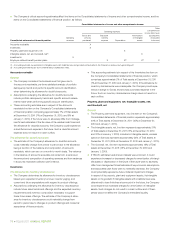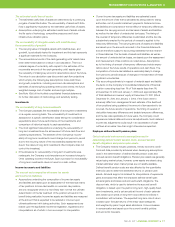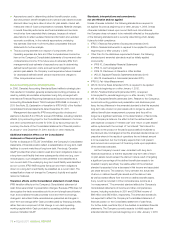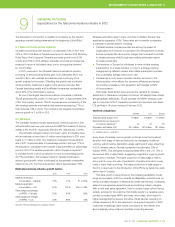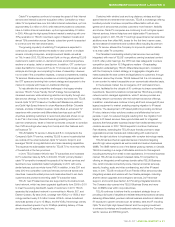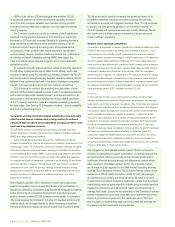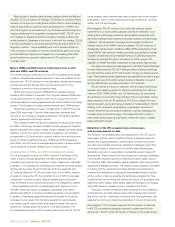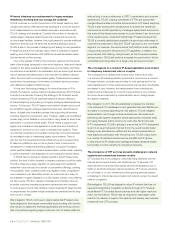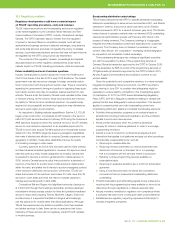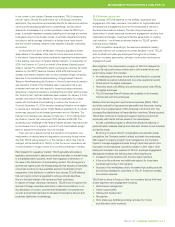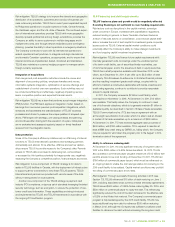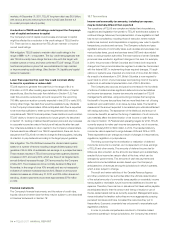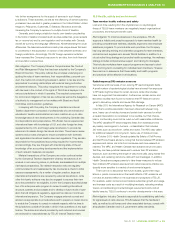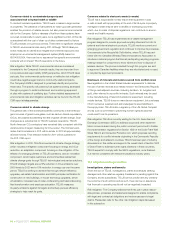Telus 2011 Annual Report Download - page 90
Download and view the complete annual report
Please find page 90 of the 2011 Telus annual report below. You can navigate through the pages in the report by either clicking on the pages listed below, or by using the keyword search tool below to find specific information within the annual report.
86 . TELUS 2011 ANNUAL REPORT
Rapid growth in wireless data volumes requires optimal and efficient
utilization of TELUS’ spectrum holdings. TELUS aims to achieve efficient
utilization of its spectrum holdings and position itself to meet increasing
levels of data traffic through the continued deployment of HSPA+ and
LTE technologies, the eventual launch of LTE-advanced technology and
ongoing development of a capacity management toolkit. TELUS’ spec-
trum strategy is designed to further strengthen its ability to deliver the
mobile Internet to Canadians in the future. In line with this strategy, TELUS
intends to participate in upcoming spectrum auctions (see Section 10.3
Regulatory matters – Future availability and cost of wireless spectrum).
If the Company is successful in its bids, the additional spectrum would
provide additional capacity and mitigate risk of increasing data traffic,
as well as allow for economic deployment of LTE services in rural
coverage areas.
Mature CDMA and iDEN wireless technologies must coexist
with new HSPA+ and LTE networks
The wireless industry continues to roll out various wireless technologies
to deliver increased data speeds required for many new wireless, IP and
data services. TELUS’ evolution to next generation wireless technologies
involves services and devices that meet the requirements of the
Company’s current and future subscriber base.
TELUS continues to support CDMA2000 3G wireless services,
including EVDO Revision A services. The Company believes CDMA tech
-
nology will continue to be used for some time to support the current
subscriber base and roaming agreements with other domestic and foreign
carriers. The Company no longer actively markets new CDMA devices.
TELUS also continues to support its Mike Push to Talk (PTT) service
using iDEN technology. Currently, Mike subscribers represent less
than 5% of the Company’s wireless subscribers. TELUS also has iDEN
roaming agreements with foreign carriers.
The Company’s near-term growth is expected to be supported mainly
by HSPA+ technology, because of HSPA’s broader geographic adoption,
greater anticipated economies of scale, superior speeds and wider device
selection. As part of a natural 4G network progression, the Company
is committed to LTE technology to support medium-term and long-term
growth of mobile broadband services. CDMA and iDEN coexistence
with HSPA+ and LTE must be managed appropriately to
ensure optimal
use of spectrum and tower facilities, and to minimize costs.
Implementation of HSPA+ and LTE technologies and systems
TELUS successfully launched its HSPA+ network in November 2009,
under a network access agreement with Bell Canada that sped up
completion and reduced the Company’s costs of deployment nationally.
In addition, LTE is leading the Company’s shift towards new technologies
starting with the urban launch in February 2012. It is expected that
LTE devices offered by TELUS would also work on the HSPA+ network
in areas not covered by LTE. Any potential roll-out of LTE in rural areas
is dependent on future Industry Canada wireless spectrum auction
rules and timing of such auctions (see Section 10.3 Regulatory matters
– Future availability and cost of wireless spectrum). Spectrum in the
700 MHz range has superior propagation capabilities that make it
effective and efficient in covering Canada’s expansive rural
geography.
In addition, these same capabilities improve the quality of in-building
coverage in urban areas. The Company expects its overall wireless
and wireline capital intensity level, excluding any capital that may be
required for wireless spectrum auctions, to be approximately 17%
of consolidated revenues in 2012. However, there is the risk that TELUS’
future wireless capital expenditures may be higher than those recorded
historically in order to meet ongoing technology investments, including
HSPA+ and LTE technologies.
Risk mitigation: TELUS’ practice is to continually optimize capital
invest ments to provide positive payback periods and flexibility in con-
sidering future technology evolutions. Some capital investments, such
as towers, leasehold improvements and power systems, are technology-
indifferent. TELUS expects to leverage the economies of scale and
handset variety of the HSPA+ device ecosystem. TELUS continues to
strategically migrate certain CDMA and Mike (iDEN) subscribers to high-
speed HSPA+ data devices, thereby providing the potential to increase
utilization of data services and stabilize revenue. TELUS also expects to
leverage the evolving LTE device ecosystem to further support this
migration of CDMA and iDEN subscribers to high-speed data services.
The reciprocal network access agreement with Bell Canada facilitated
the rapid deployment by TELUS of next generation wireless technology
and provided the means for TELUS to better manage its capital expendi-
tures. These network access agreements are expected to provide ongoing
cost savings beyond the initial network build and flexibility to invest in
service differentiation and were extended to LTE networks.
TELUS maintains a close co-operation with its network technology
suppliers and operator partners to influence and benefit from develop-
ments in iDEN, CDMA, HSPA+ and LTE technologies. By contracting
its suppliers to provide technology solutions that are amenable to future
advancements, such as LTE-advanced, TELUS can mitigate the oper-
ational disruption during technology transitions. Fundamental to TELUS’
strategy is the reuse and redeployment of application servers and
network elements that are access-indifferent, such as messaging into
the latest radio access technology. This enables TELUS to invest in
radio-based technologies as they evolve, without the need to replace
these application servers.
Maturation of the LTE ecosystem may not keep pace
with growing demand for data
The timing for the standardization and deployment of 4G LTE technol-
ogies aligns with the need for additional network capacity required to
address the surging demand for wireless data. However, just as with
any other new wireless technology, significant challenges remain that
the industry needs to overcome in the first few years following stan-
dardization, and prior to being able to successfully support large LTE
deployments. These include both technological and business challenges:
harmonization of global spectrum, intellectual property rights, support
for voice and SMS, interoperability, device availability, technology maturity,
operational readiness and costs. The wireless industry appears committed
to making LTE the worldwide technology standard, as evidenced by
research and development, testing and interoperability efforts, as well
as the number of carriers adopting the technology. Despite this, there
remains a risk that the timing of a mature and robust LTE ecosystem may
experience some delays; these delays, against a background of surging
data traffic demand, represent a risk to operators like TELUS.
The surge of mobile broadband traffic resulting from the proliferation
of smartphones and data devices, along with increased data volumes
due to the need for continuous connectivity and new applications, are
expected to continue to stress the capabilities of current 4G networks.
Risk mitigation: The Company believes that the evolution of networks
to 4G LTE is a natural progression required to sustain and to drive
data growth. TELUS’ urban LTE launch in February 2012 is appropriate


